mayan pot chocolate blow foam chocolateros
http://choco-story-brugge.be/ENG/chocolateros.htm
| ||||||||||
M5-C2-S1-MayanCulture.doc
www.nspencer.k12.in.us/hhhs/class.../M5-C2-S1-MayanCulture.doc
Feb 24, 2012 - Traces of chocolate found in Mayan pots dating from 600 BC. ... hollow handles, which were used to blow into a chocolate drink to create foam, ...Chocolate was a major force in Mayan society. Pottery cups ...
www.coursehero.com › ... › OA › OA 110
Pottery cups unearthed in the nineteenth century are from OA 110 at ... handles, which were used to blow into a chocolate drink to create foam, a practice especially ... Traces of chocolate drinks found on Mayan pottery were analyzed and the ...Archaeology of Native North America - Page 164 - Google Books Result
https://books.google.com.gt/books?isbn=1317350065
Dean R Snow, Professor - 2015 - Social Science
As important as this great cycle was to the Maya, they realized that a date like 1 ... to produce the desired foam by blowing into the spouts of the chocolate vessels. ... icons on stone panels, on painted murals, and on cylindrical pottery vessels.QI: quite interesting facts about chocolate - Telegraph
www.telegraph.co.uk › Men › The Filter › QI
Jul 21, 2009 - The Mayans who followed them called the drink cacahuatl (''atl'' means water). ... tubes into their pots so they could blow the liquid into a foam.Choco-Story, The Chocolate Museum - History
choco-story-brugge.be/ENG/chocolateros.htm
Why did local Indians call the pots unearthed by the archaeologist in the ... Blow air into the cocoa drink to create foam, which was the part most liked by the Mayans. ... later stage Mayans used to pour from one vessel into another to create foam.The Surprising History of Hot Chocolate | The Art of Manliness
www.artofmanliness.com/.../the-surprisingly-manly-history-of-hot-cocoa...
Dec 17, 2012 - The Mayans liked their chocolate hot, the Aztecs liked it cold, but all ... forth from a bowl held high into one below (a large, foam-creating swizzle ... As depicted in this photo – located at the Monasterio de Piedra .... With their pocket knives, soldiers would shave pieces of the cake off into a pot of boiling water.http://www.c-spot.com/atlas/historical-timeline/
A CONCISE HISTORY OF CHOCOLATE
Cacáo, cocoa & chocolate have played profond roles in history & in shaping modern globalism. A complex web of contacts, connections, collaborations of commerce & culture – all nodes to the various “C-spots” – in an enormous value chain spanning millennia over thousands of miles involving millions of people. The total effort required to produce & deliver finished-chocolate is planetary & enduring. Here then…
The Nibs of the Matter
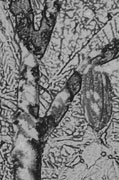 10,000 – 15,000 Years BCE– origins of the tree Theobroma cacao in, all likelihood, theAmazon Rainforest, from whose seeds chocolate would eventually be derived; the earlier date would coincide with the founding populations that peopled the Americas.
10,000 – 15,000 Years BCE– origins of the tree Theobroma cacao in, all likelihood, theAmazon Rainforest, from whose seeds chocolate would eventually be derived; the earlier date would coincide with the founding populations that peopled the Americas.7,900 BCE – The Popol Vuh, a sacred text of Mesoamericans, appears to give a long count calendar date for the first sprout of maize & – by symbolic though not necessarily historical association – cacáo, as 1 Manix (manixliterally ‘worker with the Earth’), celebrating their invention on Day One, around 7,900BCE, probably along the Pacific Coast near current day El Salvador. This mythology coincides with the oral history of the Lenca enclave there who call themselves ‘the people of corn & chocolate’.
Inside several ceramic & stone vessels, quite innovative in form & style — which served both in ceremonial settings (burials for example) & domestic kitchen ware – modern Carbon-14 Dating reveals organic residues of a diet rich in pepper (Capsicum spp.), beans (family Fabaceae), cassava (Manihot esculenta), yams (Dioscorea spp.), sweet potato (Ipomoea spp.), corn (Zea mays), coca, datura, & yage. Additionally, ancient traces of starch granules of cacáo (Theobroma spp.), plus cacao de monte (Herrania spp.), are also detected.
Cacáo appears to have been used in several ways, including a liquid, since its residues in some vessels designed with very narrow necks suggest it was poured from them.
The Mayo Chinchipe cultivated the Nacional genotype cacáo, at around 1,040 meters above sea level (an altitude higher than formerly considered possible).
Furthermore, seashells found throughout the Chinchipe basin leave clues to interactions between the Mayo Chinchipe & their contemporaries on the Pacific coast, particularly the Valdivia culture. Shells were traded for their symbolic value rather than for food. The spondylus shell, for instance, was linked to fertility by many Andean peoples in antiquity & conch shells today are still used for trumpets during indigenous rituals.
Speculation that cacáo might’ve been exchanged for these seashells, in an economic network stretching between the Amazon & the Pacific, leads on perhaps to farther voyages… particularly north to cacáo’s eventual center of domestication – Mesoamerica – where it would later be revered by the great Mayan civilization.
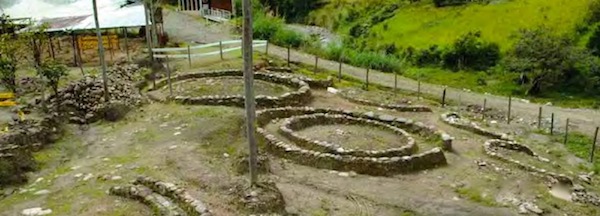
Home site (above) off the central plaza points to a structured village plan separating domestic areas from public ones for civic-ceremonies, including a cemetery reserved for the elite. Put together, these elements tell of a sedentary society based in agriculture with specialization of labor & elements of social hierarchy.
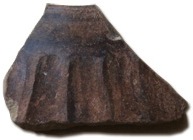 1,900 – 1,800 BCE – among the original cultivators of cacáo, The Mokaya (“People of the Corn” ironically), during Barra Ceramic Phase (thin-walled, finely finished & elaborately decorated pottery vessels); Paso de la Amada, Xoconochco (present day Soconusco), Pacific Coast of Chiapas, Mexico.
1,900 – 1,800 BCE – among the original cultivators of cacáo, The Mokaya (“People of the Corn” ironically), during Barra Ceramic Phase (thin-walled, finely finished & elaborately decorated pottery vessels); Paso de la Amada, Xoconochco (present day Soconusco), Pacific Coast of Chiapas, Mexico.In 2008, only 1 of 16 sherds suspected for cacáo-use tested positive for theobromine (a key marker for chocolate) inside a Bayo Brown slipped tecomate with vertical fluting on its exterior surface (see figures left & below) found atop Structure 4 in Mound 6 — referred to as the “Chief’s House”. Taken as a whole complex, Mound 6 & its ascending structures represent a time-lapse microcosm of a shift from simpler egalitarian agriculture to stratified centralized power. Little can be gleaned however about the details behind cacáo’s usage but this find raises questions, both functional (for chicha [alcoholic chocolate]? atole [chocolate / maize draft]? &/or possibly a balsamic-like condiment?) & social (how pervasive in the community? restricted to elites? or pre-chiefdom & for everyone?)
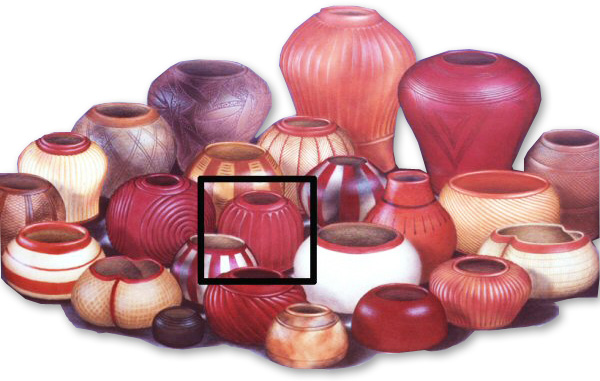
Above: Mokaya tecomatl & xicalli vessels from Paso de la Amada (drawing by Ajax Moreno); Upper Right: actual ceramic shard from the vessel (of the inset bordered in black) which tested positive for trace cacáo on its interior surface. Vessels eventually became ‘social currency’ among Mesoamericans, exchanged at feasts & ceremonial visits, preserved as heirlooms & funerary companions in the afterlife.
1,800 – 1,600 BCE - an array of pottery vessels recovered at the Olmec (olmeca: “rubber people”, derived from the Nahuatl word for rubber – ulli / olli) capital of San Lorenzo & its neighboring ritual site at El Manati test theobromine-positive, strongly indicating they once contained cacáo, most likely in some liquid form. Of particular curiosity: the finding of several hundred vessels atop a mass grave for sacrificial victims at the height of San Lorenzo’s power. Taken altogether, they furnish ample evidence of a well-attended, elite mortuary rite which included the preparation of stored cacáo draughts that were ritually served & imbibed. This service ware may have then been intentionally broken during the ceremony in an conspicuous undertaking of wealth destruction. By thus engraving cacao & human sacrifice in such a pivotal & integral way into the Mesoamerican cosmic theater that involves birth, death & rebirth, the Olmec nobility legitimized their earthly prestige & divine authority with audacious self-interest.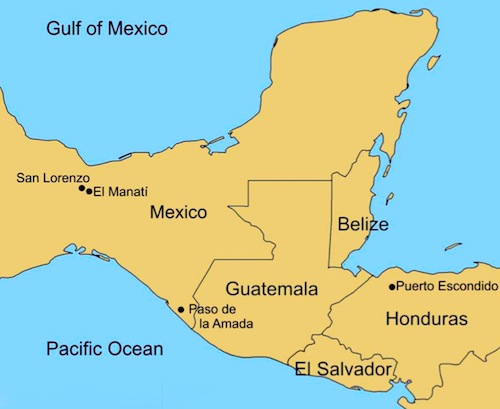 (above) map showing locations of early Mesoamerican archaeological sites where cacáo was consumed; (below) pottery vessels found at San Lorenzo that tested postive for cacáo residues used for storage, preparation & drinking (from “Cacao Use & The San Lorenzo Olmec” by Powis, Cyphers, et.al., 2011)
(above) map showing locations of early Mesoamerican archaeological sites where cacáo was consumed; (below) pottery vessels found at San Lorenzo that tested postive for cacáo residues used for storage, preparation & drinking (from “Cacao Use & The San Lorenzo Olmec” by Powis, Cyphers, et.al., 2011) 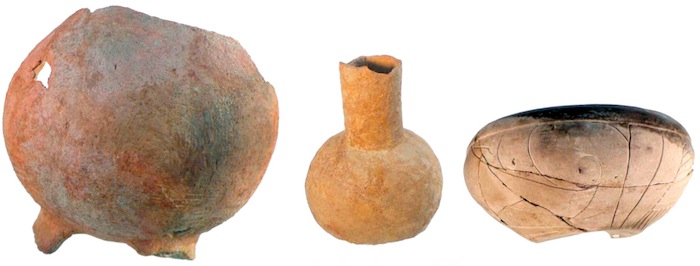
1,150 BCE – Puerto Escondido, Ulúa Valley, Honduras, Caribbean coast; Olmec-related village speculatively turns cacáo pulp into a wine
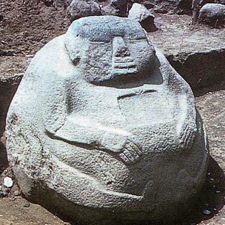
1,000BCE – 200CE – Chocolá: the very epicenter perhaps, lying on a plateau below volcanic mountain ridges at 500-1000m altitude, for a vitally important chain of revered cacáo groves in all of chocolate lore.
Along the humid piedmont zone of the Pacific slope of southern Mesoamerica extending from Xoconochco (Soconusco) Chiapas in modern Mexico, south thru the prime growing zone in Guatemala (Suchitepequez, Mazatenango, Escuintla, Guazacapán) & onward to Sonsonate (El Salvador), cacáo stood central — its worth in commerce & cosmology rivaled only by maize.
Early signs of high complexity at Chocolá are attributed to intense cultivation of cacáo, irrigated by hydraulic water springs, for the lucrative long-distance trade network. It may have indirectly borrowed from Xoconochco up the coast – an argument advanced by Yale Prof. Michael Coe in suggesting that the monumental stone-sculptors of Izapa (Xoconocho) form the connective tissue between the earlier Olmec & the later Maya that loosely ties them all together. If so, this represents a key development for the SMA (Southern Maya Area) &, plausibly, a seminal link in the rise of Classic Mayan civilization, architecture, city-states, hieroglyphic literacy, detailed ceramics & advanced math / astrology.
Many believe that cacáo culture reached its zenith there & then… the Maya naturally selecting prized cultivars for their hi-flavor, bringing forth the finest cacáo ever cultivated on Earth. Quite possibly true insofar as Friar Francisco Ximénez, noted translator of the holy Mayan text Popul Vuh, inventoried the single-origin cacáos in the Americas, saying that the absolute best grew along this Pacific coast.
Over the centuries – millennia really – the Maya developed & refined chocolate craft. They planted for variety & diversity on a stunning scale – especially by modern standards. Each selection based on desirable traits & described by respective fruit colors: (ix sac [white], ix kan [yellow], ix chak [red], ix morado [purple], & even ix box[black]).
That Chocolá’s environs & era largely coincides & overlaps with the distribution of ‘potbelly sculpture’, which appears around the Late Preclassic (c. 200CE), comprises the heart & guts for what might affectionately be termed the geographic ‘chocolate potbelly’ of cacáo.
600 BCE – Colha, Mayan stone tool production center (modern-day northern Belize), shows further archeological evidence of cacáo residues in drinking vessel
500 BCE – chemical markers for cacáo found on flat plates at Paso del Macho, Yucatán, Mexico strongly suggest a chocolate type sauce, condiment &/or garnish in cuisine other than a beverage
450 CE-
Ancient Maya City of Copán (Honduras), Mayan Classic Period; móle-prototype of animal bones (turkey & fish) with cacáo, as well as tamale platter with cacáo
The “Dazzler Vase” (below), arguably the most famed vessel from all of Meoamerica, recovered from within the royal ‘Margarita Tomb’ in Copán, Honduras. It sports a goggle-eyed figure peering out the window of a talud-&-tablero style structure that eerily resembles another tomb nearby called the ‘Hunal’. Mayanist David Stuart views the figure as the spirit of Copán founder King K’inch Yax K’uk’ Mo’ looking in on his Queen wife (& mother of their son King K’inich Popol Hol) buried in the Margarita Tomb across from his own royal crypt at Hunal. A well-preserved layer of cacáo residue lines the bottom of the vase, retaining the hue of dark chocolate, the remains of a possible ritual draft. The intent is that cacáo would sustain the departed on their long journey thru the underworld… the finest offering made even more sacred by its escorting them.
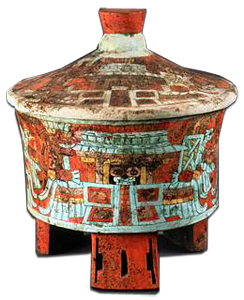 590 CE – Home-Grown Chocolate: Joya de Cerén (The Jewel of Cerén in the Valley of Zapotitlán, El Salvador), a Mayan agricultural village & Pompeii of the New World, preserves a young cacáo tree with a flower just opening up in ash – from the nearby volcano Loma Caldera – the oldest known cacáo tree in existence; immediately south of Structure 4, next to the storehouse for Household 4 where inside that building were pots with cacáo in them
590 CE – Home-Grown Chocolate: Joya de Cerén (The Jewel of Cerén in the Valley of Zapotitlán, El Salvador), a Mayan agricultural village & Pompeii of the New World, preserves a young cacáo tree with a flower just opening up in ash – from the nearby volcano Loma Caldera – the oldest known cacáo tree in existence; immediately south of Structure 4, next to the storehouse for Household 4 where inside that building were pots with cacáo in them
(photo courtesy Payson Sheets who led the recovery of Cerén in 1976)
683 CE – death of King Pakal (Ajaw K’inich Janaab’ Pakal), Palenque / B’aakal (Mexico). Arguably the most renowned of all Mayan monarchs anywhere, in addition to the longest ruling (more than 3 K’atuns = 68 years). Palenque / B’aakal flourished during Pakal’s reign to eclipse the great city of Tik’al. Carved stone-relief on the North & South ends of his famed sarcophagus depict his mother, Queen Zac K’uk’, as re-born thru a cacáo tree.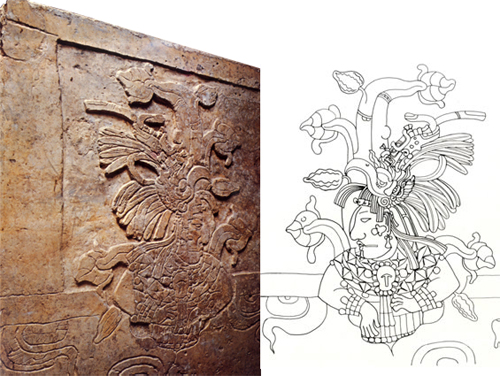
Bas-relief of Queen Zac K’uk’ on the North End of her son King Pakal’s sarcophagus (left); mirror image (right) drawn by Merle Greene Robertson
770 CE – Earliest Chocolate in North America? Site 13 near Canyonlands in present-day Utah… home to peoples who grew corn & dwelt in subterranean houses. Ceramic bowls excavated from the area contain traces of theobromine & caffeine — two markers for chocolate derived from cacáo nuts imported from thousands of miles away to the south in a trade network that included parrots & copper bells among other goods.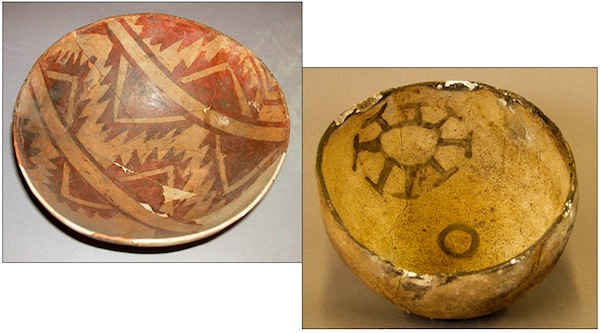
‘… and a bowlful of chocolate, please.’ ‘Large or small?’ 8th century pottery vessels from the American Southwest that tested positive for trace amounts of chocolate compounds (Peabody Museum of Archeology & Ethnology, Harvard University)
790 CE – Bonampak / Bòonam Pak’ (Mayan for ‘Painted Wall’) Chiapas, Mexico; fresco of cacáo bundle containing 40,000 beans as tribute to the king on the Bonampak Mural – considered the pictorial encyclopedia of a Mayan city.....................Chocolate Strains
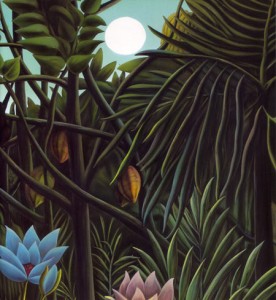 Practically every popular resource divides Theobroma cacao into 3 camps: Criollo, Forastero, & Trinitario; an overly simplistic & deeply flawed scheme. We reject this particular division. Show Less «
Practically every popular resource divides Theobroma cacao into 3 camps: Criollo, Forastero, & Trinitario; an overly simplistic & deeply flawed scheme. We reject this particular division. Show Less «The cacao woods are another world… woods of fairy tales… dark, mysterious, shadowed & cool – VS Naipaul.

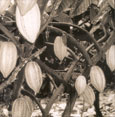 Chocolate craft begins with seeds (often dubbed “Jungle M&Ms”) from zeppelin-shaped fruits referred to as ‘pods’. Botanists loosely categorize them an epigynous berry or pepo. They hang like so many colorful lanterns to lure pollinators & porters (midges, monkeys & man) on a tree whose species name is cacáo, one of 22 species or so (15 of which are edible with Bicolor, Grandiflorum & Angustiflorium the other relatively well-known / cultivated members) belonging to the genus Theobroma.
Chocolate craft begins with seeds (often dubbed “Jungle M&Ms”) from zeppelin-shaped fruits referred to as ‘pods’. Botanists loosely categorize them an epigynous berry or pepo. They hang like so many colorful lanterns to lure pollinators & porters (midges, monkeys & man) on a tree whose species name is cacáo, one of 22 species or so (15 of which are edible with Bicolor, Grandiflorum & Angustiflorium the other relatively well-known / cultivated members) belonging to the genus Theobroma.Hence, Theobroma cacao.
Perhaps the greatest tree on Earth other than the Christmas tree, Theobroma cacao grows in the tropics, all the way around the “20/20 zone” – roughly 20 degrees north & south of the equator. Also known as the ‘cocoa belt’, the zone reaches its most northern extension in Hainan, China at 20ºN & its most southern at about 24ºS near São Paulo, Brazil. This natural habitat stretches far from any garden-fruit one may pick in a backyard like strawberries or grapes: the primeval rainforests… those naturally moist environments receiving evenly distributed rain fall in rather undefined seasons deep with permeable layers of well-drained, loam-clay soils & slightly acidic pH.
The species’ origin dates back 10,000 –15,000 years. Its birthplace was postulated by E. E. Chessman in 1944 based on the preceding work of 2 men: a) the observations of F.J. Pound who discovered enormous diversity among cacáo’s population while exploring the Amazon Rainforest a few years earlier in 1937-38; & b) botanist Nikolai Vavilov’s theory, now generally accepted, that the origin of a species is the place where its members show the highest level of genetic diversity. As an analogy, among humans Africans possess the most genetic variation on Earth to suggest that the cradle of modern humans rests in an area near the coastal border of Namibia / Angola. From these Chessman reasoned cacáo’s center of origin was the confluence of the rivers Napo, Caquetá, & Putumayo leading to the Amazon River, right in the cross-borders area of present-day Peru,Colombia, & Ecuador. Genetic research published in October 2008 by Juan-Carlos Motamayor adds weight to Chessman’s view.

image above courtesy of Samantha Madell
Practically every popular resource divides cacáo into 3 primary varietals: Criollo, Forastero, & Trinitario; an overly simplistic & deeply flawed scheme, & by no means hard & fast distinctions because cacáo is notoriously promiscuous, engendering classification nightmares, & often plain guesswork. With so much genetic cross-pollination, hybridization, mutation, & recombination, it’s rare & increasingly difficult to find any pure forms. To adapt a thought from Immanuel Kant… out of the crooked timber of Theobroma cacáo, nothing entirely straight can be picked. And yet complex crosses are necessary in order to select for genotypes with fine flavor, high yield, & resistance to diseases/pests.Complicating matters further, all-too-frequent mislabeling of strains at the research level, as well as botanical names getting tossed in & mixed up with trade/brand names, creates a confused landscape.
In the future, primary variety names will likely become secondary to either the name of the country in which they grow, or to cultivar (i.e., ‘cultivated variety’) names. This in some ways returns cacáo back to its roots when people could identify it with a high degree of specificity, illustrated by the Itza Mayan who planted various types of cacáo, each selected for desirable traits & described by their respective fruit colors (white, yellow, red, purple, & even black).
This section reflects current state-of-the-art in pursuit of accuracy & the primordial urge to ‘get it right’ (while realizing our limitations), to do justice to the tree lest fallacies take hold permanently as folksonomy. It’s based on mounting empirical data-points, some of it morphological analysis (structural traits such as physical appearance) &, increasingly, from more precise genetic markers.
Given the rapid rate of research, however, this is bound to change as cacáo, like all life, is in a constant state of evolution well beyond its origins.
Geneticists Raymond Schnell, Dapeng Zhang, & Motamayor of the USDA Agricultural Research Service are in the deep stages of identifying by busily fingerprinting the DNA of 3,000+ cacáo clones that should solve both the relationships & origins puzzle. By combing the genome of the tree for genetic markers linked with specific traits — such as fruit quality, environmental adaptation, & disease / pest resistance – they’ve developed filters to make corrections for common sequencing errors. Thousands of such genetic markers called SNPS (Single Nucleotide Polymorphisms) stand additionally as signposts pointing out the degree to how much or how little cacáo types are interrelated.
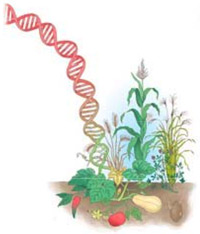
Just as Gulliver’s travels took him to the Academy of Lagado below the flying sky-city of Laputa where the air is filled with math, music & technology, & “fruits of the earth shall come to maturity at whatever season we think fit to choose, & increase a hundredfold more”, breakthroughs with somatic embryogenesis & transgenic cacáo (GMO) in the genomics research of Siela Maximova & Mark Guiltinan at Penn State could have equally far-reaching consequences: bioengineered plants; speed-breeding with patented miracle seeds sprouting trees that bear traits for high-yield, drought-tolerance, & disease resistance; DNA markers to expand chocolate’s flavor-complex; a self-sweetened chocolate without the need for added sugar?
Hopeful reality or twisted fantasy that pursuing such schemes amounts to extracting sunbeams out of cacáo beans or, on the dark side, an ecological nightmare?
Right before the dawn of the 21st century, Figueira et.al. studied the effects of genetics vs. environment, comparing Brazil to Malaysia, concluding that genetics contribute to chocolate flavor more than characteristics rooted in terra… a chocolate version of the ‘nature vs. nurture’ argument. And while ‘genetic drift’ continues, there remain enough of what insiders term ‘genotypic & consequently organoleptic distinctions’ to identify one strain from another. In other words, you can still taste the difference. Here’s the field guide.
(Image above right, copyright Cornell University)



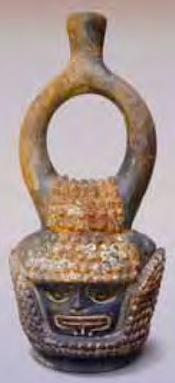
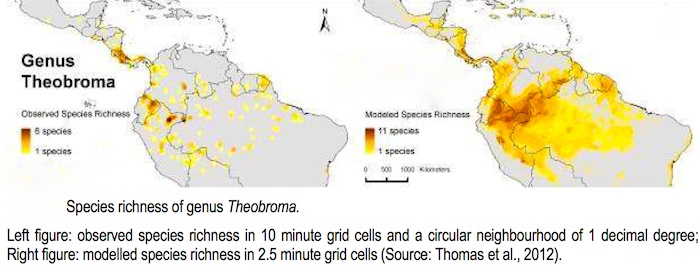
No comments:
Post a Comment